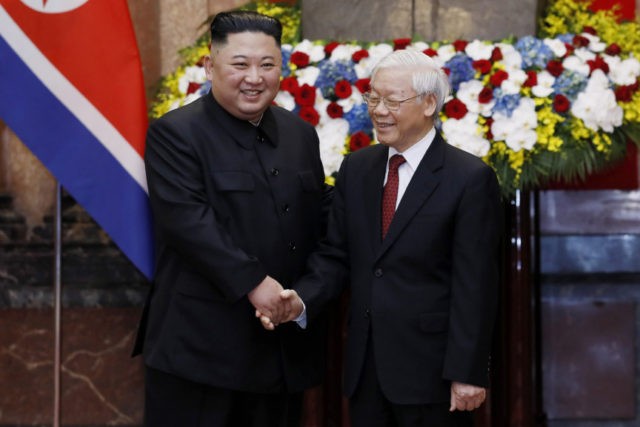HANOI, Vietnam (AP) — North Korean leader Kim Jong Un spent his last day in Hanoi on Saturday, laying large red-and-yellow wreaths at a war memorial and at the mausoleum of national hero Ho Chi Minh as he continued an official state visit meant to cement his image as a confident world leader after his summit breakdown with President Donald Trump.
After solemnly participating in the wreath-laying ceremonies under an overcast sky, surrounded by Vietnamese soldiers in crisp white uniforms and his own entourage of top North Korean officials, Kim was driven in his armored limousine to the border with China where his private train was waiting take him on a 60-plus-hour trip through China and back home to Pyongyang, the capital of North Korea.
In Dong Dang, where Kim was to board his train, hoards of media and security officials crowded the train station. The street was lined with schoolchildren and locals waving North Korean and Vietnamese flags.
Since Trump left, Kim has been keen to show himself as a poised leader taking his rightful place on the international stage. He met Friday with President Nguyen Phu Trong, the country’s top leader and Communist Party chief.
On Saturday, Kim, his trademark high-and-tight pompadour a bit disheveled, walked slowly behind a wreath with his name on it and a message that said, “I mourn the heroes and patriotic martyrs,” as it was taken to the Monument to War Heroes and Martyrs. He also laid a large wreath at the Ho Chi Minh Mausoleum, where he bowed and walked inside.
As Kim met with officials in Hanoi, the United States and North Korea have both been spinning their versions of what happened during one of the most high-profile diplomatic collapses in recent years.
Talks between Kim and Trump broke down on Thursday, the second day of their two-day summit, in a dispute over how much sanctions relief Washington should provide Pyongyang in return for nuclear disarmament steps. Despite a senior North Korean official’s suggestion — in a rushed, middle-of-the-night news conference called to dispute Trump’s version of the summit’s end — that Kim may have “lost the will” for diplomacy, the North Korean leader seems to have emerged from the diplomatic wreckage as a winner.
Kim stood shoulder-to-shoulder with Trump at the summit, an image that allows his propaganda services to portray him to his people and supporters as the leader of a nuclear-armed power, not an international pariah that starves its citizens so it can build nukes and missiles. He answered questions with humor and ease when confronted by an aggressive international media contingent here. And, crucially for his image at home, he stood firm on his demands for the relief of sanctions imposed over a nuclear program North Korea says it built in the face of unrelenting U.S. hostility meant to end its leadership.
Kim, as he considers his next move after Hanoi, will also be backed by state-controlled media that were already busy portraying the summit as a victory for their leader, saying Kim and Trump “appreciated that the second meeting in Hanoi offered an important occasion for deepening mutual respect and trust and putting the relations between the two countries on a new stage.”
North Korea said it had asked for partial sanctions relief in return for closing its main nuclear site at Yongbyon, an important nuclear-fuel production facility but not the only place the North is believed to make bomb fuel.
The United States also put its interpretation on the summit breakdown, with senior officials saying that North Korea wanted billions of dollars in sanctions relief in return for only partial dismantlement of Yongbyon, and demanded the North scrap more of its nuclear program for such a high level of concessions.
It’s unclear what will come next: Working-level meetings among experts to close the negotiating gap? Another summit? Or will Trump, consumed with controversy in Washington and burned by the failure in Hanoi, lose interest?
The worst-case scenario would be a return to the personal insults and threats of war between Trump and Kim in 2017 as the North staged a series of increasingly powerful weapons tests, including a nuclear detonation and displays of long-range missiles that can target the U.S. mainland, though experts believe those ICBMs are not yet complete.
Trump maintained ahead of the Hanoi summit that the economic benefits of a deal could push Kim to give up his nuclear ambitions.
Kim came into the summit feeling confident that he could settle something that would end painful economic sanctions while letting him keep much of his nuclear program and only making a “a variety of gestures that mimic disarmament,” Jeffrey Lewis, a nuclear expert at the Middlebury Institute of International Studies at Monterey, wrote after the summit collapse. This outcome would be a signal that “the world must live with North Korea’s bomb, but Kim won’t rub it in anyone’s face.”
“Since it would be utter madness to try to topple a nuclear-armed dictator, it seems obvious which side should yield,” Lewis said. If Trump “does not accept the reality that we now live with a nuclear-armed North Korea, then we are doomed to the collapse of negotiations, and perhaps even a return to the terror of 2017.”
___
Associated Press writer Hyung-jin Kim in Hanoi, Vietnam and video journalist Emily Wang in Dong Dang, Vietnam, contributed to this report. Foster Klug, AP’s bureau chief in South Korea, has covered the Koreas since 2005.
___
Follow all of AP’s summit coverage: https://apnews.com/Trump-KimSummit

COMMENTS
Please let us know if you're having issues with commenting.